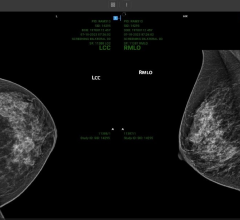
January 7, 2013 — At RSNA 2012, GE Healthcare announced a first-of-its-kind agreement with the University of Wisconsin (UW) School of Medicine and Public Health for the purpose of providing physicians with more tools to optimize radiation dose, take clinically-useful images, and potentially reduce the frequency of repeat computed tomography (CT) scans.
Clinical professionals at the School of Medicine and Public Health, a recognized leader in lower-dose CT imaging, will develop a suite of protocols, which will be regularly updated and improved; GE will make them available, along with GE Healthcare reference protocols, to better serve its customers.
GE Healthcare and the University of Wisconsin also plan to make these protocols available to users of many of GE Healthcare’s current CT systems.
“We are excited to share our protocols with current and future GE Healthcare CT users,” said Myron Pozniak, professor of radiology and chief of the section of abdominal CT, UW-Madison. “At the University of Wisconsin School of Medicine and Public Health, we’ve built a rigorous process for protocol development and quality control, and these protocols will be the result of that process.”
The protocols are being designed and optimized for multiple, very specific, clinical applications. Within each clinical application, the UW team plans to develop several protocols for patients of different sizes ranging from small children to large adults.
The agreement also calls for the School of Medicine and Public Health to continue to develop and improve the protocols so that end users would receive regular updates as improvements are made.
In addition to clinical and lower dose opportunities of these protocols, there is a potential real savings to end users. According to a presentation from the William W. Backus hospital at the 2011 annual meeting of the RSNA, the cost of reviewing and modifying 30 protocols for dose optimization is approximately $165,050 a year. Each site would still be ultimately responsible for any protocol implemented in their program, but they may be able to leverage the foundational ground work UW-Madison has laid.
Customers around the U.S. continue to show substantial interest in GE Healthcare’s Blueprint for Lower Dose Benchmark program, which was launched in June 2012. GE worked with four leading health systems to pilot the program for CT.
The Blueprint Benchmark can help a healthcare provider understand the strengths and opportunities within its CT imaging program as compared to industry guidelines and best and better practices. Based on information provided by the healthcare provider, GE’s Low Dose Architects provide a report that can serve as a “blueprint” for the healthcare provider as it works to put in place the people, processes and technology to define and enhance their radiation dose management goals.
In addition to the Blueprint, GE Healthcare’s lower-dose vision equips radiologists and radiographers with technologies that can help them reduce patient dose and improve image quality. These solutions include:
- ASiR, a lower dose image reconstruction technology enabler, installed on more than 1,800 GE CT systems worldwide that has provided more than 20 million scans to date.;
- Veo, the world’s first ever model based iterative reconstruction that enables CT imaging under 1 millisievert with profound clarity;
- CT Dose Check, a feature that helps users manage exposure pre-scan through notifications and alerts to operators;
- Free radiation safety iPad apps and lower-dose webinars offering education and CE credits to healthcare professionals globally;
- DoseWatch, a multi-modality dose tracking and reporting tool; and
- Innova interventional imaging systems designed to maximize dose efficiency, reduce quantity and simplify dose management.
For more information: www.gehealthcare.com


 April 23, 2024
April 23, 2024 








